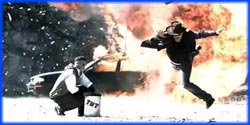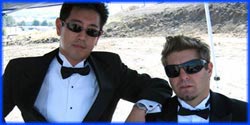


Premier Date: June 3, 2012
busted
Adam and Jamie started by fitting Buster with accelerometers and dropping him from 35 ft (11 m) to determine his survivability. A control drop with no bubble wrap gave an impact force of 300 g, while covering him with 4 in (10.2 cm) of wrap as in the video gave 260 g. Both results were well above the maximum survivable force of 75 g.
They decided to do small-scale tests in order to determine the amount and/or type of wrap needed to make the landing safe (defined as 10 g or less), and began dropping a human analog onto the wrap instead of covering it. Using a fall height of 6 ft (1.8 m) and a plastic pipe filled with cannonballs, they found that 16 in (41 cm) of wrap gave between 22 and 25 g. Further tests on Buster from 15 ft (4.6 m) allowed them to design an alternating layer/coil wrapping design that reduced the impact to 15 g.
Under Jamie’s supervision, the crew fitted Adam with safety equipment, covered him in three layers of this design, and dropped him from 15 ft (4.6 m). The resulting force on landing was 9 g; however, Adam found the total weight of the padding (150 lbf (667 N)) very uncomfortable and hit his head on the support board underneath him. When Buster was wrapped up and dropped from the full 35 ft (11 m), he experienced forces of 29 g (torso) and 48 g (head), indicating that he would survive with some degree of injury. Because the circumstances shown in the video would have proven fatal, Adam and Jamie declared the myth busted.
busted
Examining the film scene, the Build Team decided to use enough rockets to launch the seat to a height of 20 to 25 ft (6.1 to 7.6 m). They obtained a car similar to the one in the scene, modified it to accept an ejector seat, and fitted it with enough rockets to generate 800 lbf (3,559 N) of thrust. A test on the right-side-up car succeeded, but filled the passenger compartment with smoke and flames.
After resetting the seat and turning the car upside down, the team fired the rockets but were unable to flip the car. Grant noted that the rockets’ thrust was too small compared to the weight of the car (approximately 4,000 lbf (17,793 N)). A second test, with enough rockets added to generate this much thrust, also failed and set the interior on fire. Declaring the myth busted, they modified the car to use a high-pressure nitrogen cannon and successfully flipped it back onto its wheels.
Previous: Special 18: Mailbag Special